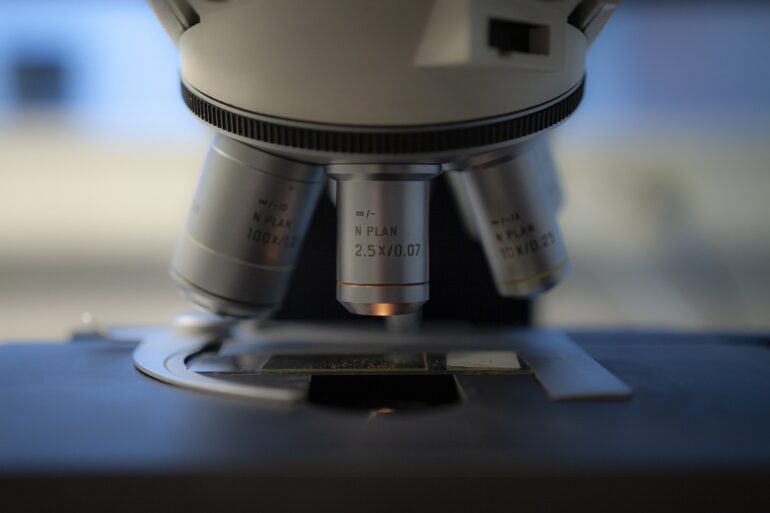TL;DR:
- AI has revolutionized lab technology by simplifying complex processes and improving efficiency.
- AI is used for analyzing large amounts of data quickly and accurately, automating manual tasks, and conducting image analysis.
- Predictive modeling with AI helps scientists make accurate predictions and identify new materials with desired properties.
- AI optimizes experimental design, reduces errors caused by human bias, and streamlines workflows.
- Benefits of AI in lab technology include increased accuracy in data analysis, improved efficiency, identification of hidden patterns, and reduced risks in handling hazardous materials.
- Challenges include ensuring representative and unbiased data, transparency and explainability of AI systems, job displacement concerns, and cybersecurity risks.
- The future of AI in lab technology holds promise for advancements in diagnostics, personalized medicine, and research and development.
- Continued investment in research and development is crucial for harnessing the full potential of AI in lab technology.
Main AI News:
The realm of laboratory operations has undergone a remarkable transformation with the advent of artificial intelligence (AI), revolutionizing complex processes and enhancing overall efficiency. In this feature, we delve into the profound implications of AI in lab technology, exploring its manifold benefits, the challenges it presents, and the future possibilities it holds.
How AI Transforms Lab Technology
AI serves as a catalyst in the field of lab technology, empowering scientists to swiftly and accurately analyze copious amounts of data. By automating manual tasks like pipetting and sample preparation, AI liberates researchers’ time, allowing them to focus on more critical endeavors.
A prime application of AI in lab technology lies in image analysis. By training algorithms to discern intricate patterns or structures within microscope images, researchers can promptly identify areas of potential interest for further investigation. This has expedited the identification of disease biomarkers and drug targets, fostering breakthroughs in healthcare.
Predictive modeling stands as another noteworthy application of AI in lab technology. Through the ingestion of vast datasets into machine learning models, scientists can forecast outcomes with a remarkable degree of precision. For example, this approach has facilitated the discovery of novel materials possessing desirable properties for energy storage applications.
Moreover, AI aids labs in streamlining their workflows by optimizing experimental design and minimizing errors arising from human fallibility or bias. This augments the pace of scientific discovery and bolsters reproducibility across studies.
Benefits Unleashed by AI in Lab Technology
The integration of artificial intelligence into lab technology has yielded a multitude of advantages. Foremost among them is the heightened accuracy achieved in data analysis and interpretation. By leveraging AI, labs can swiftly analyze vast datasets, surpassing human capabilities while mitigating errors stemming from fatigue or human fallibility.
Another paramount benefit of employing AI in lab technology is the marked improvement in efficiency. AI-powered systems, having learned from prior experiments and results, excel at predicting future outcomes with greater accuracy. Consequently, scientists can optimize their workflows, substantially reducing the time and resources required for research endeavors.
Moreover, AI unveils patterns imperceptible to the human eye. By meticulously analyzing extensive datasets over prolonged periods, AI discerns subtle changes that elude human observers.
Furthermore, the use of AI in lab technology diminishes the risks associated with handling hazardous materials. Robots infused with AI capabilities can proficiently execute perilous tasks, effectively safeguarding human personnel.
Challenges to Overcome
While AI has propelled lab technology to new heights, it does come with its fair share of challenges. One of the foremost obstacles lies in ensuring the representativeness and impartiality of the data employed to train AI models. Inadequate diversity or biased data collection methodologies can engender inaccurate predictions or classifications by AI systems.
Transparency and explainability also pose a significant challenge in the realm of AI. As AI systems grow increasingly complex, comprehending the rationale behind their decision-making becomes arduous for researchers and users alike. This lack of transparency undermines trust in AI technology and impedes its widespread adoption.
Furthermore, concerns surrounding job displacement loom large as AI continues to automate an array of tasks. It is imperative to carefully consider the repercussions of these changes on lab workers and devise measures to mitigate any adverse effects.
Addressing cybersecurity risks is another critical aspect when harnessing AI in lab technology. The digitization and interconnectedness of sensitive information create vulnerabilities that malicious actors can exploit, necessitating robust safeguards.
Conlcusion:
The integration of artificial intelligence into lab technology has significant implications for the market. By streamlining operations, enhancing efficiency, and unlocking new possibilities in research and development, AI is poised to revolutionize the laboratory industry. The benefits of AI, such as improved accuracy in data analysis, optimized workflows, and the identification of hidden patterns, will empower businesses to drive innovation and make informed decisions.
However, it is crucial for market players to address challenges related to data representativeness, transparency, job displacement, and cybersecurity to fully capitalize on the potential of AI in the lab technology market. By embracing AI and investing in its development, businesses can gain a competitive edge and transform how they approach scientific research and discovery.

